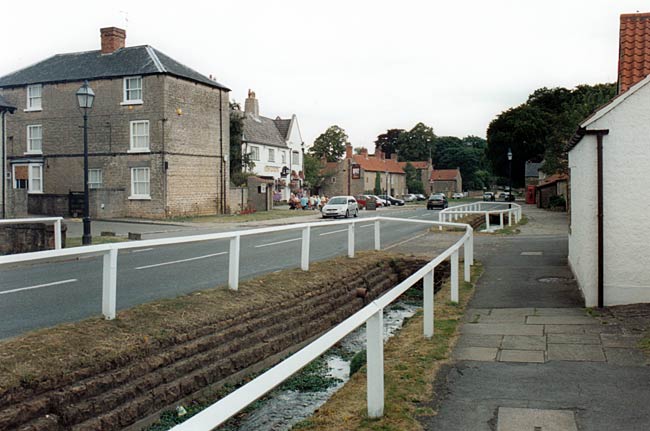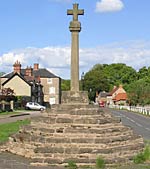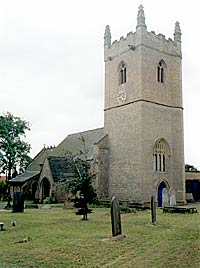< Previous | Contents | Next >
The Wonderful Water Wheel

Linby village in 2003.

One of the crosses at Linby in 2002.
LINBY. Its collieries have not robbed the heart of the village of its old charm, for here are stone cottages with red roofs, an ancient church, and two fine crosses on flights of steps, with a stream flowing on each side of the spacious road between them. It is uncertain what the crosses were, but it is probable that both marked the boundary of Sherwood Forest. The older cross has a restored shaft on its original seven-sided steps; the other, coming from about 1660, is a charming picture spanning the stream, backed by tall trees and a flower-bordered drive.

Linby church in 2003.
The church was in Domesday Book, and there is much Norman masonry in the north wall. The Norman arch of the north doorway is over one of later time, and is sheltered by a pretty 16th century porch. A Norman doorway and the head of a Norman window are built up in the south wall of the 13th century chancel, entered by a lofty arch only a little younger. At one side of the arch is a peephole. The nave arcade, a piscina, and the corbelled arch of the 15th century tower are 700 years old. One of two old glass fragments in a 600-year-old window shows a crowned head.
On the outskirts of the village is Castle Mill, with battlements to justify its name. Though much of it is 18th century, it keeps up the tradition of a Linby mill in Domesday Book, and is still grinding corn where corn was ground for the monks at Newstead centuries ago. Its magnificent water-wheel, over 100 feet round and one of the biggest in England, is turned by the water from a great lake on the other side of the road. The lake is filled by a stream which rises beyond Newstead and, after turning the mill wheel, goes on through the meadows as the little River Leen.
The great days of the Leen were in the 18th century, when it turned many a mill which had been converted for the spinning of cotton and flax. One of them was this Castle Mill, which will always be famous because here James Watt set up his first engine for a cotton mill in 1785. But the great days of the river were cruel days for the pauper apprentices who provided the labour for the mills, and the Linby registers tell of too many poor London boys buried in this churchyard.
